What is the Synology GS Series? And Who Is It For?
Synology has been in the market for almost 25 years now, and during that time, they have rolled out numerous large-capacity solutions. However, the GS series is the brand’s most significant move thus far towards true data center-class scale storage. Last year saw the release of the HD6500 60-bay solution, and the previous year, they introduced their SA and UC3200 active-active solutions. This year, the GS Series and the GS6200 are their latest efforts to provide enormously accessible, expandable, and reliable enterprise storage.

The TL;DR About the GS (GridStation) Series, the GS6200 and the NS4825 Switch
Synology GS Series Overview
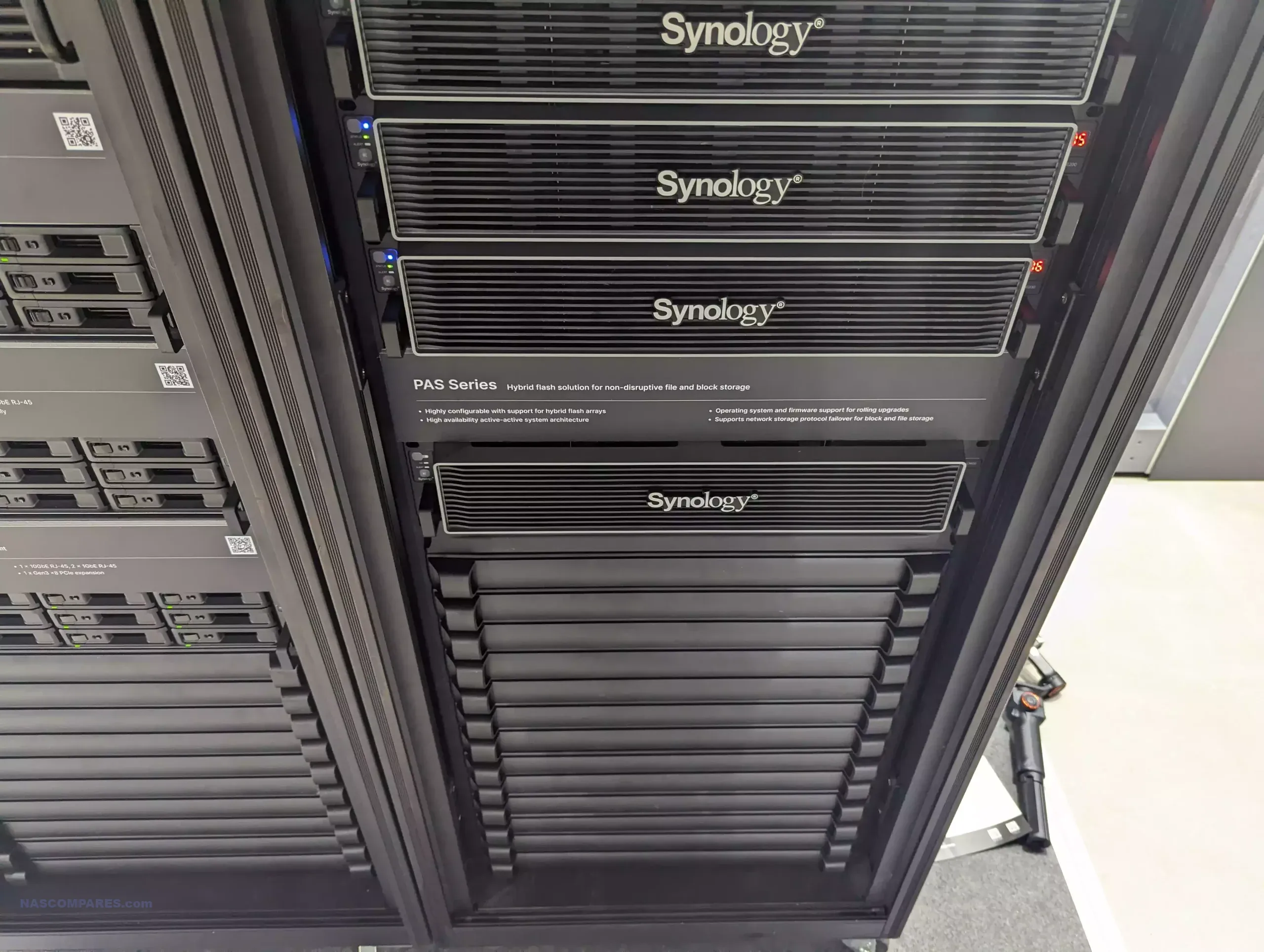
General Information:
- Product Line: GS Series
- Type: Scale-out data storage and management platform
- Key Features:
- Highly efficient and scalable architecture
- Supports up to 96 nodes per cluster
- Raw storage capacities of up to 20 PB
- Supports up to 150,000 concurrent connections for Synology Drive and Office
Benefits:
- Operational Continuity: Non-disruptive operations and data integrity
- Ease of Management: Simple and transformative management for businesses and large organizations
- Platform Compatibility: Compatible with almost all known platforms today
- Scalability: Suitable for mid to large enterprises with virtually any need
Applications:
- Collaboration suite: Drive, spreadsheets, documents, and presentations benefit from the GS series
Synology GS6200 Specifications
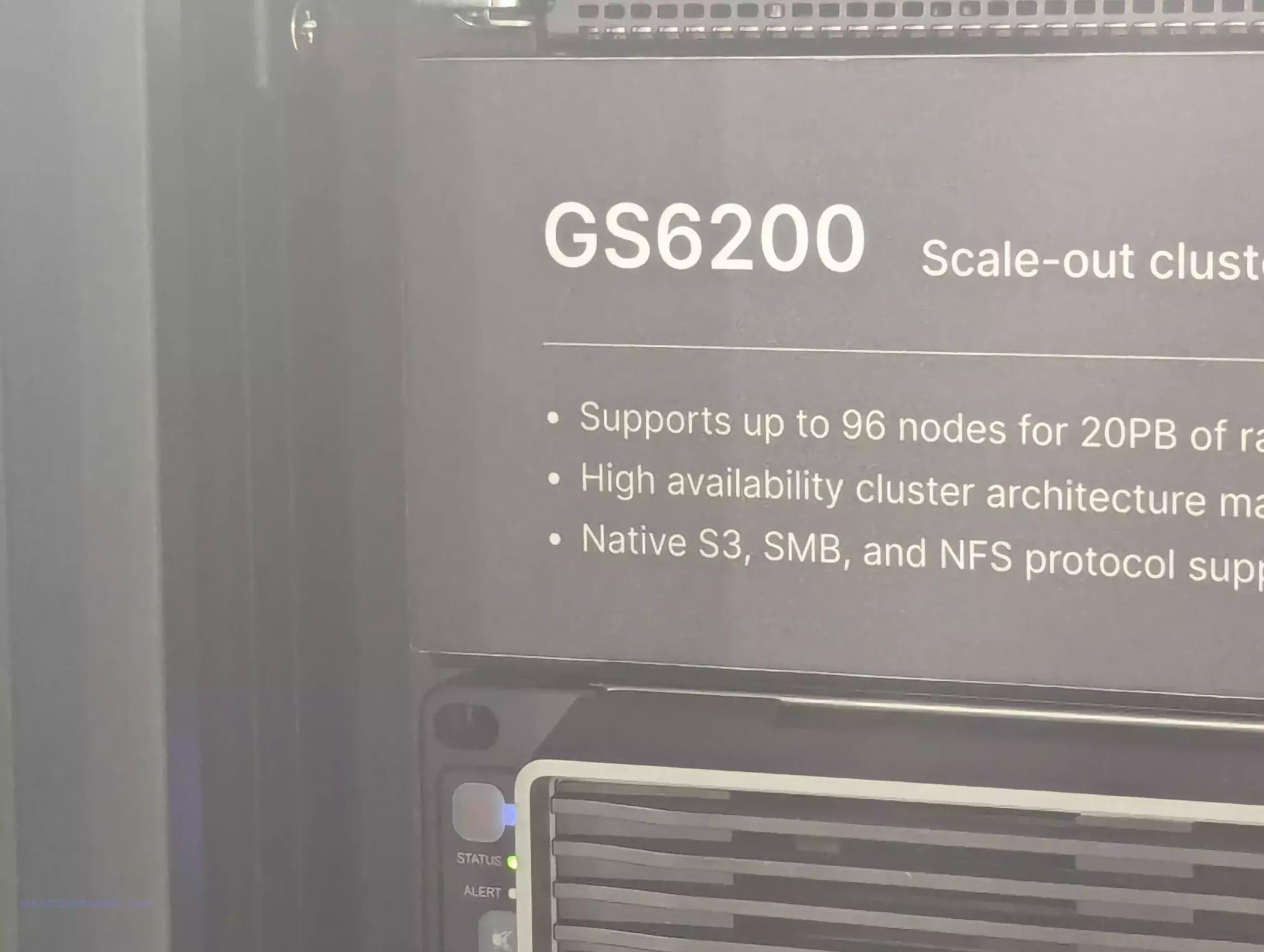
Key Features:
- Management System: Powered by GSM (GridStation Manager)
- Scalability: 3 to 96 nodes per cluster
- Storage Capacity: Up to 20 PB of raw capacity per cluster
Performance:
- High Connection Performance: Supports up to 150,000 simultaneous users
- Supported Protocols: SMB, NFS, S3
Operating System:
- Design: Ensures operational continuity and data preservation
- Interface: Simple and user-friendly management interface
Advantages and Practical Applications
- Expandability: Easily expandable without losing performance
- Cost Efficiency: Optimizes resource usage and reduces maintenance costs
- Applications: Suitable for various sectors including business, education, and medical industries
NS4825 Network Switch
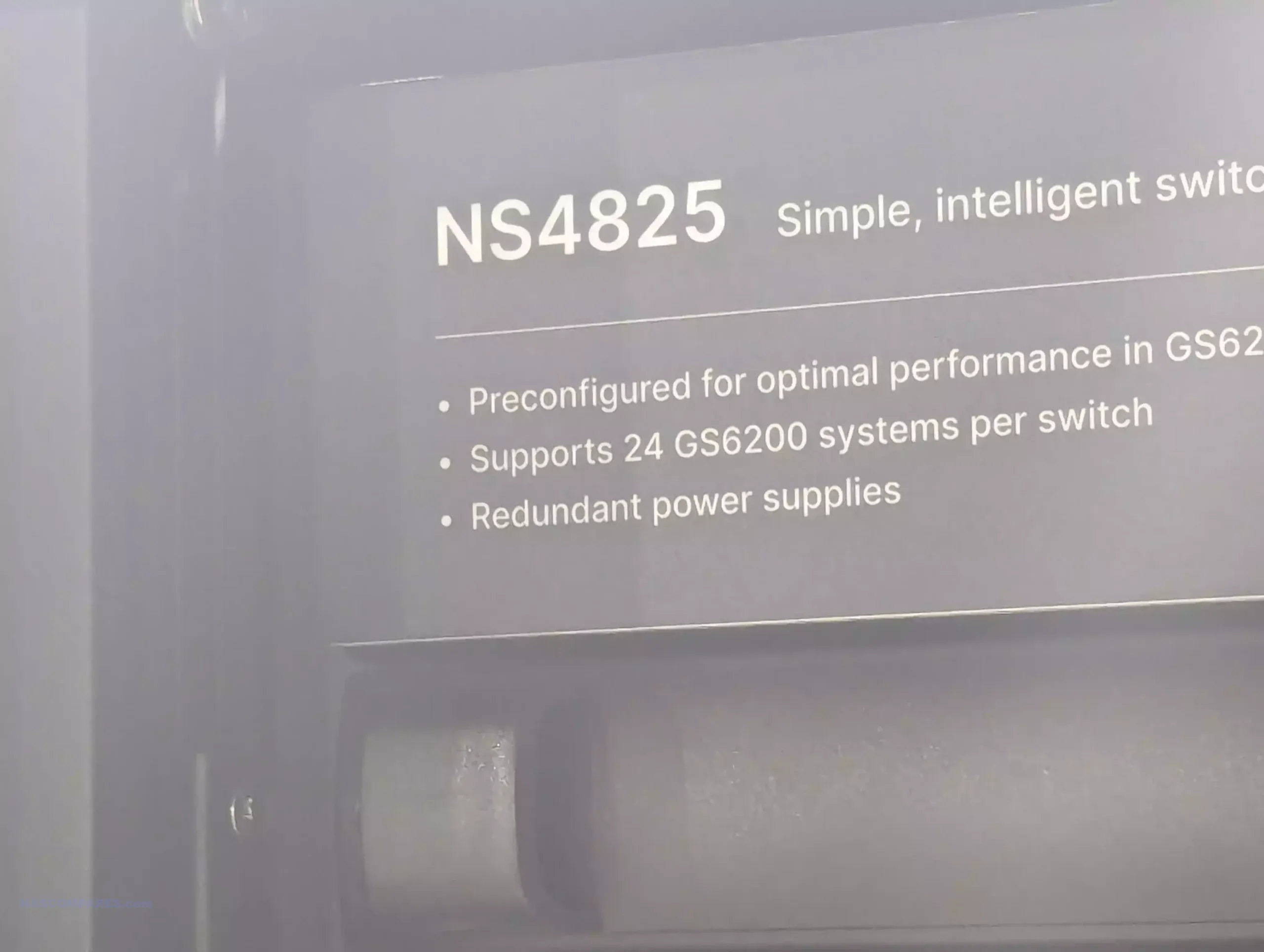
Key Features:
- Preconfigured for GS6200: Supports up to 24 connected GS6200 nodes/systems
- Connectivity: Connects to up to 3 other NS4825 switches for managing a 96-node cluster via 100GbE connections
- Potential Capacity: Manages over 5 PB of storage per switch
Up until this point, the majority of Synology rackmount systems were designed to be used primarily as single-unit solutions, and most of them have been expandable. This means that these larger and more powerful server solutions can have additional storage bolted on via large expansion units, allowing businesses to increase their shared storage over time. This kind of scale-out storage is very effective for adding more storage to an existing solution, but not for creating large, privately managed storage areas (also known as nodes) that form one larger storage pool (known as a cluster). These solutions have a failure point in the main server that, if impacted, cannot rely on the connected expansion systems to pick up the slack or fluidly handle active connections, identities, or access. This is where the GS Series comes in.

The GS Series is a high-capacity and high-performance rackmount server (the GS6200) that provides a similar experience to other high-powered, large-scale Synology solutions. However, the GS Series is designed to be deployed alongside other GS6200 units—up to 96 units, to be exact! Although this might appear comparable to the existing NAS + expansions model in their portfolio, in the GS Series, each system is a fully-featured server solution that can run independently or in unison (the preferred and recommended method) with the rest of the GS systems in its cluster. Each system features its unit number on a digital display on the front panel. Each GS6200 is a 12-bay unit that can support Synology 20TB media, meaning each system can potentially support up to 240TB of storage capacity. Add that up across 96 individual GS6200 nodes, and you have well over 20 petabytes of storage to work with (more like 23+ PB).

This is a considerable amount of system and storage management across the entire cluster. To address this, Synology is also rolling out an enterprise switch exclusive to this service, which can also be integrated into your existing enterprise switch (Cisco, etc.). Synology does not seem to have plans to broaden their range to include network switches, but I can see the logic of rolling out their own in the GS6200 series. Unlike a traditional expansion cluster (i.e., NAS + SAS-connected expansions), there is a lot more traffic management required, and this switch will do more than just exchange packets; it will also manage and control the cluster in a considerably more native Synology way than using a third-party switch for the cluster would.

The Synology GS Series represents the company’s latest advancement in enterprise storage, designed to meet the needs of large-scale data management. With the ability to integrate up to 96 nodes per cluster and provide over 20 petabytes of raw storage capacity, the GS6200 offers a solution for organizations with extensive data storage requirements. This system is aimed at businesses, educational institutions, and government agencies that need a scalable and efficient method for handling significant amounts of data. Each GS6200 unit is capable of supporting high concurrent connections, up to 150,000 users simultaneously, making it suitable for environments with a large number of users accessing data concurrently. The system supports various protocols including SMB, NFS, and S3, which allows for flexible integration with existing IT infrastructure. This flexibility ensures that organizations can maintain their current systems while scaling their storage capabilities as needed.
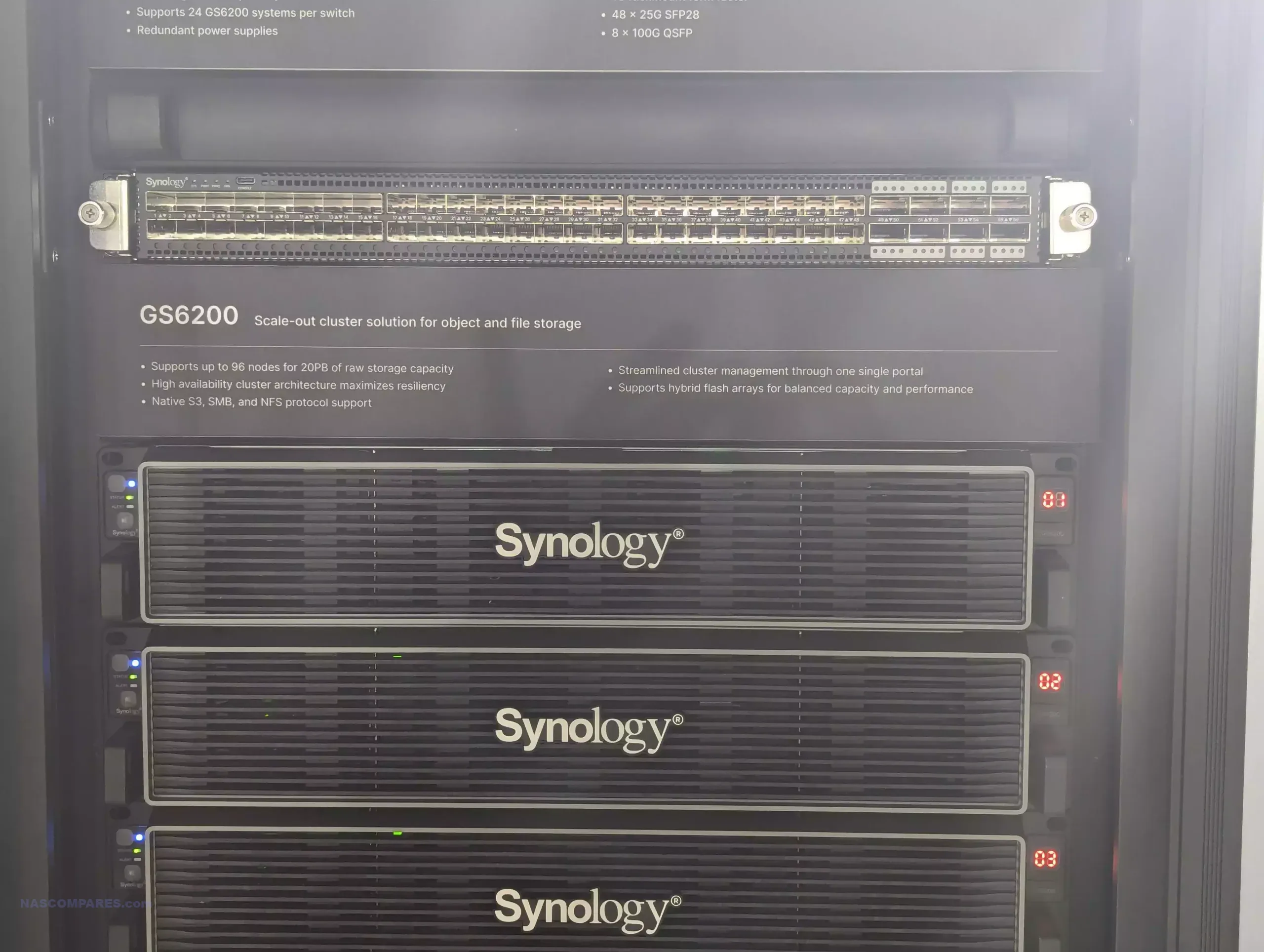
The GS Series is equipped with a new operating system designed to ensure operational continuity and data integrity, even during maintenance or upgrades. The management interface is user-friendly, facilitating straightforward monitoring and management of the cluster. This design aims to minimize the complexity involved in managing large storage environments, making it easier for IT administrators to maintain system performance and reliability. To support the GS6200 cluster, Synology has introduced the NS4825 enterprise switch. This switch is designed to handle data traffic efficiently and integrate with the GS6200 systems. The NS4825 is intended to offer a more cohesive management experience than third-party switches, streamlining the scaling and maintenance of the storage cluster. This addition emphasizes Synology’s approach to providing an integrated solution for enterprise data management.
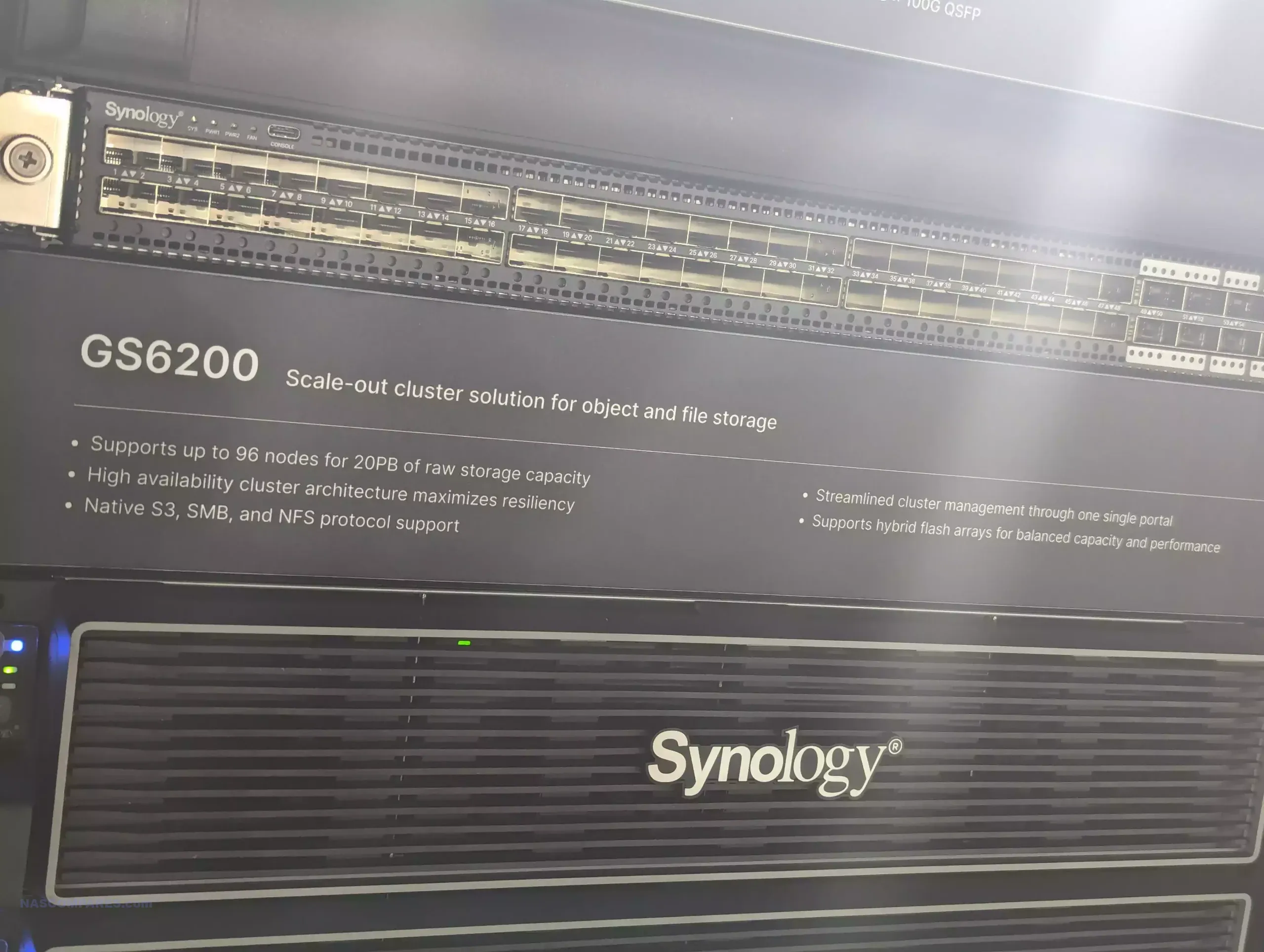
The GS Series, currently just the GS6200 and NS4825, aims to provide a comprehensive and scalable solution for organizations looking to expand their data storage capabilities. The system is designed to be flexible, reliable, and straightforward to manage, positioning it as a practical choice for entities requiring substantial data management infrastructure. We will be covering more of what came out of the Synology Solutions Exhibition 2024 later this week.
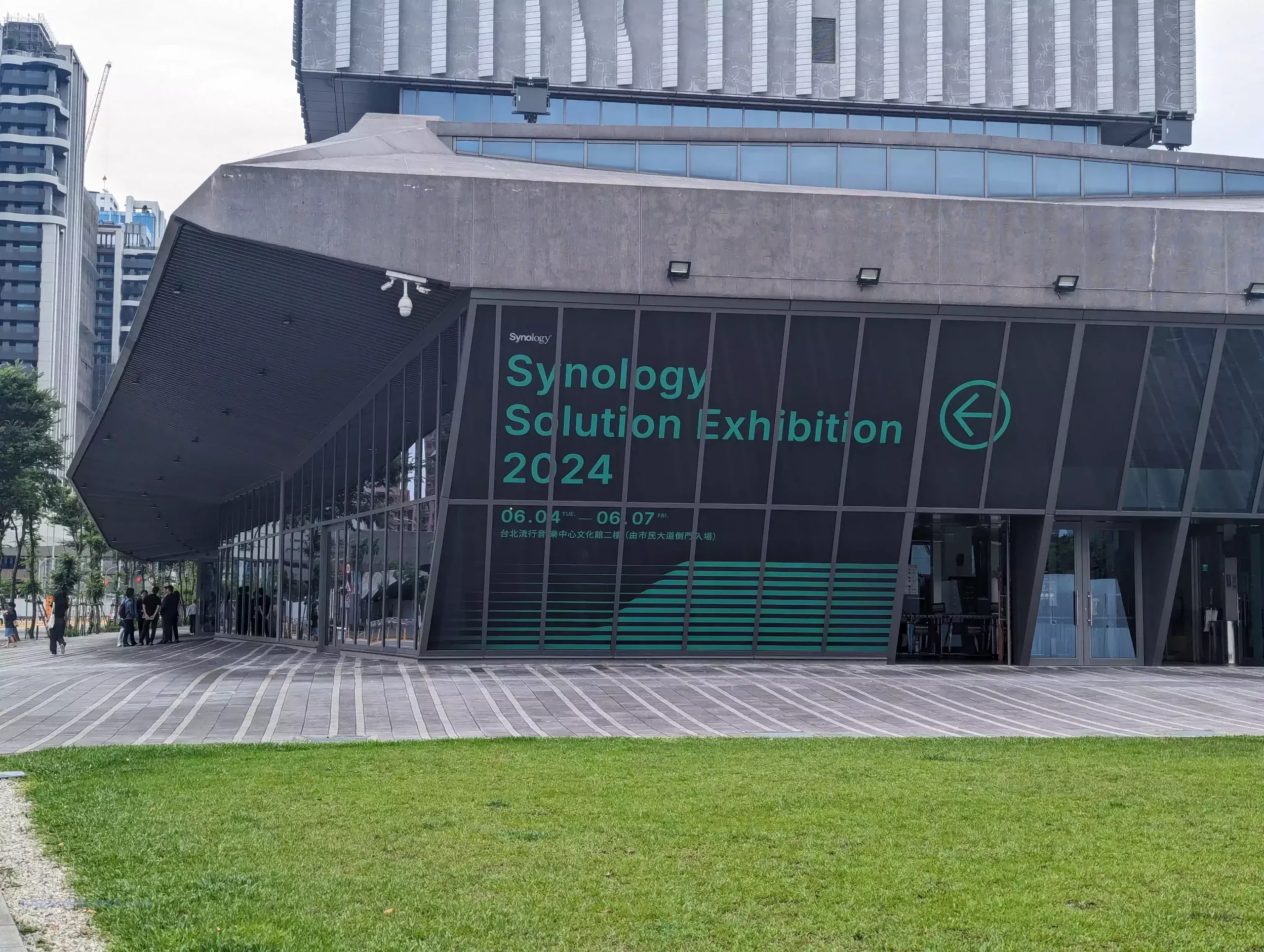
Alternatively, you can watch the full summary below from our YouTube Channel HERE:
📧 SUBSCRIBE TO OUR NEWSLETTER 🔔
🔒 Join Inner Circle
Get an alert every time something gets added to this specific article!
This description contains links to Amazon. These links will take you to some of the products mentioned in today's content. As an Amazon Associate, I earn from qualifying purchases. Visit the NASCompares Deal Finder to find the best place to buy this device in your region, based on Service, Support and Reputation - Just Search for your NAS Drive in the Box Below
Need Advice on Data Storage from an Expert?
Finally, for free advice about your setup, just leave a message in the comments below here at NASCompares.com and we will get back to you. Need Help?
Where possible (and where appropriate) please provide as much information about your requirements, as then I can arrange the best answer and solution to your needs. Do not worry about your e-mail address being required, it will NOT be used in a mailing list and will NOT be used in any way other than to respond to your enquiry.
Need Help?
Where possible (and where appropriate) please provide as much information about your requirements, as then I can arrange the best answer and solution to your needs. Do not worry about your e-mail address being required, it will NOT be used in a mailing list and will NOT be used in any way other than to respond to your enquiry.

|
 |
The BEST NAS of 2026.... ALREADY??? (UnifyDrive UP6)
How Much RAM Do You Need in Your NAS?
A Buyer's Guide to Travel Routers - GET IT RIGHT, FIRST TIME
Jonsbo N6 DIY NAS Case Review
The Best Bits (and Worst Bits) of NAS of 2025!
Minisforum MS-02 Ultra Review
Access content via Patreon or KO-FI
Discover more from NAS Compares
Subscribe to get the latest posts sent to your email.


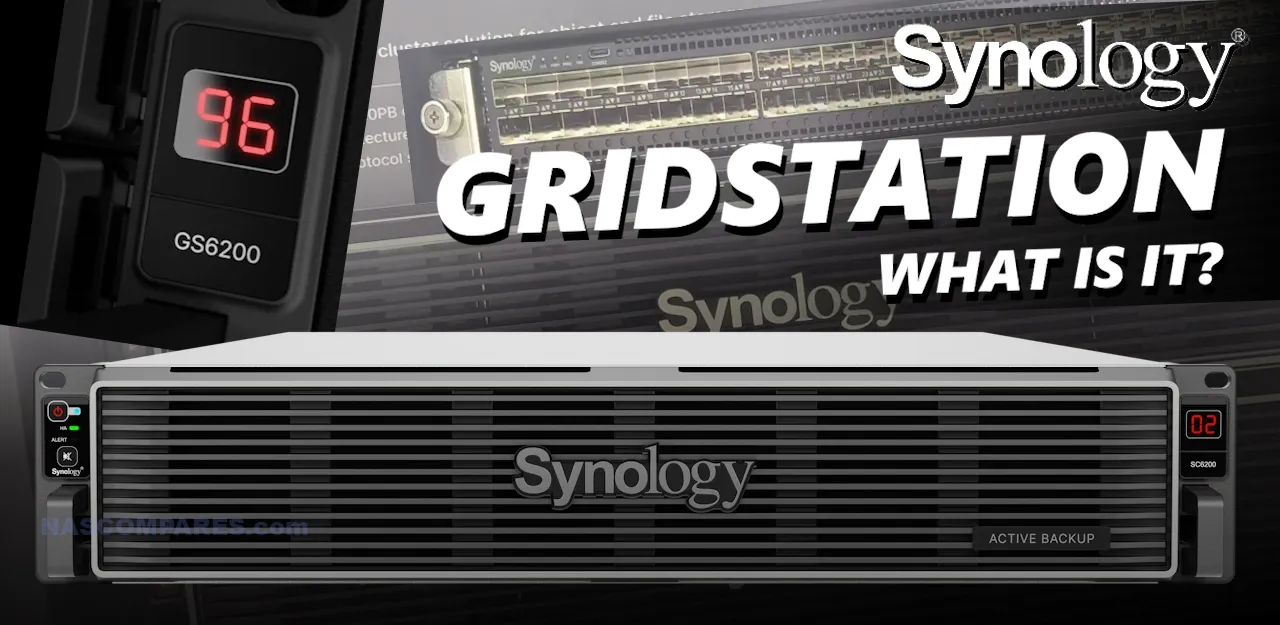



How does Synology GridStation compare to DataDirect Networks GridScaler?
REPLY ON YOUTUBE
Will they launch another flashstation , the 6400 is getting ‘old’
REPLY ON YOUTUBE
How does the Synology GridStation differ from RackStation? Another question, how does GridStation compare to DDN GridScaler and the HPE successor?
Rackstation have and admin panel with “app store”. Gristation only have backup suite available no other apps.
Is there any relationship between GridStation and DDN GridScaler? Are the applications and use cases any similar? The product names are similar.
Synology has left home users
REPLY ON YOUTUBE
20 Petabytes, sounds like an ideal solution for my Plex needs. ???? Does it come with integrated graphics, though? ????
REPLY ON YOUTUBE
Good morning when would come the new 924+, is it expected in 2024 or 2025?
REPLY ON YOUTUBE
qnap been the front runner for a couple years now for my nas. I don’t see that changing soon. I’m a regular consumer maybe prosumer, and I’m not synology’s target customer I don’t think.
REPLY ON YOUTUBE
Looking more and more like Apple with it’s lighting cables. Why can’t I use my own hard drives Synology?
REPLY ON YOUTUBE
I had problem about my synology nas
And Steve Baker
Technical Support Engineer write me about my problem that
We are sorry to hear that your DS218 has to be reset. This is likely caused by an issue in the DSM operating-system.
We understand that you are worried about losing your data. Please rest assured, your data should not be affected by the reset as the OS and data are stored in separate partitions on the drives. When re-installing the OS, the system should normally not touch the data-partitions of your drives.
I beleived and i did what he said now all my data erased omg i shocked after sir Steve Baker dissepeared i am alone there is nothing in my hands
Synology is regret bad nas choose qnap there isnt good support for problemss !!!
There is no good service and support becarefullll!!!
REPLY ON YOUTUBE
Ok, time to look around for another brand.
REPLY ON YOUTUBE
Xpenology users are happier as ever
REPLY ON YOUTUBE
Synology to SOHO users: “you didn’t like our underpowered overpriced hw, our vendor-lock aspirations, our substandard client software? Well f u, we don’t need you, have a nice day!”
REPLY ON YOUTUBE
In my business we have a RS1221+ and that’s enough to handle the backups and a couple of dockers images we don’t want to deploy in our on site kubernetes cluster. I am looking at upgrading it, though, and I’m looking at the RS2821+ as a good place to go. But it’s just too old now. And it’s the same for the RS4021xs+ which would also be an option. It bugs me that they don’t have any upgrades for what used to be their core business but seem completely focused on new areas – this is generally not a good sign for a business, whether it is for them or not remains to be seen. Sure, a new RS2824+ (and all the other models that should be updated) isn’t very sexy, but it is overdue – not doing it is a sad statement in itself.
REPLY ON YOUTUBE
Can you please clean your phone/camera lenses before filming. Every time you take your phone out to record someting, wipe the lens on your trousers/sleeve. 95% of this video looks like it’s filmed with an inch of Vaseline on the lens!
REPLY ON YOUTUBE
I’ve been watching this channel for months debating on a DIY build or just getting a Synology, but was waiting to see some new models, dunno how much longer I’ll wait for them to release a new 4 or 5 bay, was really hoping my first NAS would be running DSM
REPLY ON YOUTUBE
Who’s designing these? Look like A/C units from the 50s…
REPLY ON YOUTUBE
Seems very weak. They need to shape up.
REPLY ON YOUTUBE
I think these are rebadged, the storage would be Seagate, and the switch will be rebadged Cisco or similar. Even the HPE MSA and Dell ME4 are Seagate-based, HPE and others modify the storage management software, features and brand it their own. I’m concerned that Synology constantly falls behind on hardware, with poor excuses for the lack of 2.5gb, 5gb as standard, and rely on improvements in software to carry them, software good, hardware poor.
REPLY ON YOUTUBE
It’s nice to see that they’re finally expanding to the enterprise space. Hopefully they do not mess up the roadmap and properly test their features before release rather than to pull the plug after the fact.
I’ve been bitten once when deploying an additional RS2818RP+ for a customer back in 2020 where the first unit supported 200TB volume (if the memory was upgraded, which we did) but the second unit didn’t because Synology silently removed support for volumes exceeding 108TB in their DSM updates without any notifications.
They didn’t indicate this change in any release notes or changelogs and we only found out when we had tried to deploy the 2nd unit 6 months later.
Their support email response literally just amounted to “Welp… We removed the support for larger volumes because there may be some performance issues; good luck” – thankfully, we could still manually create and format the volume via SSH.
REPLY ON YOUTUBE
I’m interested in picking up the ds 1821+ and upgrading to 10 gb port and renewed 22 tb seagate ironwolf hhd and using the ssd for cache. It’ll be primarily used as a media storage pool (mp3s and mp4s files will take up roughly 70 tb)
What would that be the best decision? This is my first Nas purchase, and I have been following your channel for a while now. I feel like you’re the best to ask as a professional who’s unbiased.
REPLY ON YOUTUBE
I’m sorry Synology is about to find out what real competition is like…. the fact they think they can go toe to toe with enterprise level vendors is showing me they are utterly delusional. Looks like they dumped on their user base to go in other uncharted directions …. Hello Asustor
REPLY ON YOUTUBE
I was really hopping for nvme for home
REPLY ON YOUTUBE
I’m happy to see more cameras. I’m slowly migrating most of my camera fleet (no more Chinese cameras) to Synology. I’m disappointed that they don’t have a PTZ yet. I’ve been very pleased with the image quality and AI features of their cameras. I recently had to replace a dead 4 bay, and got a DS1821+ . I had been waiting for the next 8 bay DS+ to come out, but fate didn’t let me. They still haven’t replaced it yet. So, I don’t feel so bad.
REPLY ON YOUTUBE
The trouble dear Mr Synology (or QNAP for example) is that the established Large enterprise storage vendors have decades of experience in their market segment and have done the things you are just providing now, for ever. So why would I choose you? I think you should stick to home user, soho/ super techy user and small business.
REPLY ON YOUTUBE
My next NAS upgrade will be a UGREEN ????
REPLY ON YOUTUBE
UGH! I need a proper DROBO replacement. A DAS that’s USB 3.2Gen 2 or Thunderbolt 3 or 4 speeds and able to swap out drives as you needed to increase the storage pool. If there is a solution out there I have missed it! Love the coverage, Thanks!
REPLY ON YOUTUBE
How to kill your product in 2024 slap a subscription on top. I buy equipment annually for roughly 450k and I’m fed up with all subscriptions. I want to own my own infrastructure.
REPLY ON YOUTUBE
It was a good decision to buy the Ugreen Nas. Unfortunately there is nothing new from Synology for private users
REPLY ON YOUTUBE
O well, time to drop synology for home, im due for drive upgrades so will take the opportunity to build my own nas, time to work, been checking the videos here, many excellent suggestions
REPLY ON YOUTUBE
offloading AI to third-party isn’t really a problem, I can easily run LLM locally on a PC/server, definitely more secure/private solution than going some (paid) online service, and easier to scale out than proprietary in-the-box solution
REPLY ON YOUTUBE
Still feel like something is going to drop this year for 5-8 bay desktop units, notice the 1522+ and 1821+ aren’t in stock on amazon (as if there is a pause before the new models come into play)
REPLY ON YOUTUBE
I had a feeling new cameras were coming considering how low stock the initial ones were.
REPLY ON YOUTUBE
Their current business practices means they are a no buy decision.
REPLY ON YOUTUBE
Synology is not for consumers any more.
I could kick myself for changing from QNAP to Synology.
REPLY ON YOUTUBE
I already get my ‘active protect’ from my Firewalla with no subscription fee! ????
REPLY ON YOUTUBE
Long live the 1821+ ????
REPLY ON YOUTUBE
Why does the computex void look like you are laid on the bathroom floor ????
REPLY ON YOUTUBE
Synology can’t talk about their prosumer products because it’s a very competitive market. The new intel and amd product line will have a hard impact on what’s to come. There are more than enough enterprise and consumers out there that Synology won’t want to lose. They have to be quiet until release date. It’s just smart business tbh.
REPLY ON YOUTUBE
6:08 man that was scary
REPLY ON YOUTUBE
those fuckers synology took our money and said thank you all to support us and now drop us like we are no more good for them ! thank you synology !
REPLY ON YOUTUBE
Can you use locally hosted LLMs for the AI? The whole idea to have a Synology is to have my data private.
REPLY ON YOUTUBE
Thanks for the video, but disappointing as prosumer. Was hoping for a DS1825+, but if doesn’t come soon will look at other options. Nice to see a 4K camera but prefer turrets.
REPLY ON YOUTUBE
I was hoping for a refresh on the 8 bay 1821+. Maybe they still will. I also understand the big money is in mid to large corporate solutions so maybe they just focused on that and will still do a refresh for us small prosumers.
REPLY ON YOUTUBE
ds1525+ ???
REPLY ON YOUTUBE
To me, all this tech is a bet on a high AI invested world and user dependence on corporate Enterprise services.
CCTV and insanely high end massive server stacks.
REPLY ON YOUTUBE
If we were hoping to see DS1825+ and Synology walks away from us, what do you recommend? Home built?
REPLY ON YOUTUBE
So business-friendly that I’m still waiting for Active Backup for Business to support Debian 12 that was released a year ago. Being so far behind the notoriously slow Debian release cycle takes some serious neglect…..
REPLY ON YOUTUBE
I guess they are okay with the likes of ugreen taking over the home and small business market with their lack of offerings for that area and lack of competitive price/performance.
REPLY ON YOUTUBE
The bullet cam has optical zoom and license plate detection
REPLY ON YOUTUBE
did it feel like there was a gap in the exhibition where small business NAS solutions could have been presented? I could imagine that Synology is rethinking their upcomming devices on the hardware side due to the emerging competition.
REPLY ON YOUTUBE
1:14: Is that a Synology branded switch above the GS6200 label?
REPLY ON YOUTUBE
Nothing for home users ????
REPLY ON YOUTUBE
I was hoping to see a RAID SSD Beestation or similar….
REPLY ON YOUTUBE
Was waiting for this!!
REPLY ON YOUTUBE
So, in short, no (hardware) refresh for the consumer nor promuser nor SMB from Synology. (for the moment?)
And they are aiming for enterprise more & more, so it seems. Plus (optional) subscriptions.
(to me a personal a rabbit-hole I try to avoid, but inevitable nowadays, where you own nothing)
I am an enterprise user but to date I really have not seen appealing arguments that would make me re-consider Synology, sorry!
I will watch their stream(s) to find out more details.
But I guess no golden nuggets from Synology.
REPLY ON YOUTUBE
No new small business nases?????
REPLY ON YOUTUBE